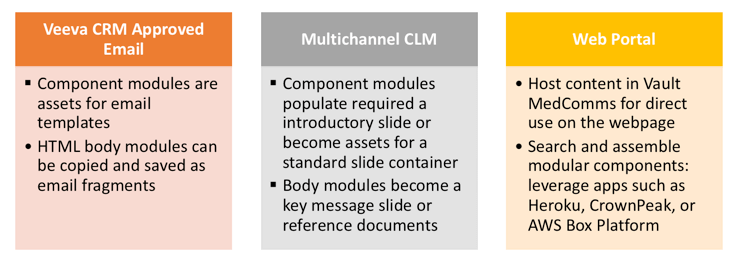Blog
Increasing ROI of Multichannel Medical Information
Jul 03, 2018 | Debby Nemecek
Jul 03, 2018 | Debby Nemecek
With increasingly complex medical treatments, having the right scientific data can make all the difference at the point of care. Healthcare providers (HCPs) may have minutes – if that – to make critical treatment decisions.
Ensuring that all medical information and field-based medical content is accurate and consistent, regardless of channel or geography, is challenging without a structured governance strategy. And once the information is published, medical affairs teams struggle to locate and update all materials in response to a market event or label change.
To increase consistency and reuse, companies are structuring their content in new ways. A modular approach to content eliminates the manual effort of traditional methods – making it far easier to ensure accuracy across channels.
Modular Response Content
Medical information is delivered as a scientific summary or in a question and answer format. In addition to the central message, an essential introduction and footer content are included to ensure compliance and correct messaging for the intended audience. Let’s call these later modules “components,” and the central message the “body.”
The response body stored in Vault MedComms can then be used across varying channels:
- Reference information for MSLs or call center staff directly in Vault MedComms
- Fragmented email content in Veeva CRM Approved Email
- Support media in a CLM presentation in Veeva CRM
- Searchable content into an external web portal, such as with self-service HCP portals
Each channel may demand different introductions or closing statements based on the messaging goals. But all channels share indications, disclaimers, and warnings. Content creators can also author these as “components,” easily mixing and matching as needed to create a complete document.

Modular content makes it easier to assemble information and extend reach across channels. And with fast access to the right information, HCPs can improve patient outcomes.
And when an indication is updated for a product, updating one component that’s leveraged across multiple channels is easy and fast. Instead of searching for 100 individual documents that share the same indication statement, users are identifying and updating, at most, one indication file per channel.
For instance, at one top 20 biopharmaceutical company, modular content strategy is increasing ROI while making it faster and easier for HCPs to get the latest information. The company recently launched an HCP portal, powered by Vault MedComms, to serve approved medical information to HCPs on-demand. With a single source of truth for all content, they’re able to ensure a consistent customer experience across channels while meeting HCPs’ need for digital information.
Keys to Success
Following this modular strategy requires planning, business processes, and governance to ensure the return on investment. Here are some best practices we’ve learned along the way:
1) Define current & future channels, content structure, and standards for file type, format & styling
- Do your MSLs need Word format to be able to email responses??
- Will you offer content online such that HTML may facilitate a better mobile experience?? Do you have a corporate or brand guideline for styling to ensure the ability to seamlessly?
- leverage the same modules across multiple channels?
2) Authoring resources should be identified to support this strategy using agencies and/or applications (Word templates, online HTML conversion tools, Drawloop, Author-it, etc.) based upon the defined content structure and channel
3) Publishing plan

4) Governance will define the importance of standard templates, and authoring & update processes; define access privileges; and establish “source of truth” locations to ensure content does not become out of sync between applications
- Establish business rules for content access, creation, and update
- Define content process for module availability and proper expiration
- Designate a librarian to ensure proper reuse, avoid duplication, ensure proper use of templates
- Generate regular metrics to tracking reuse versus new content creation